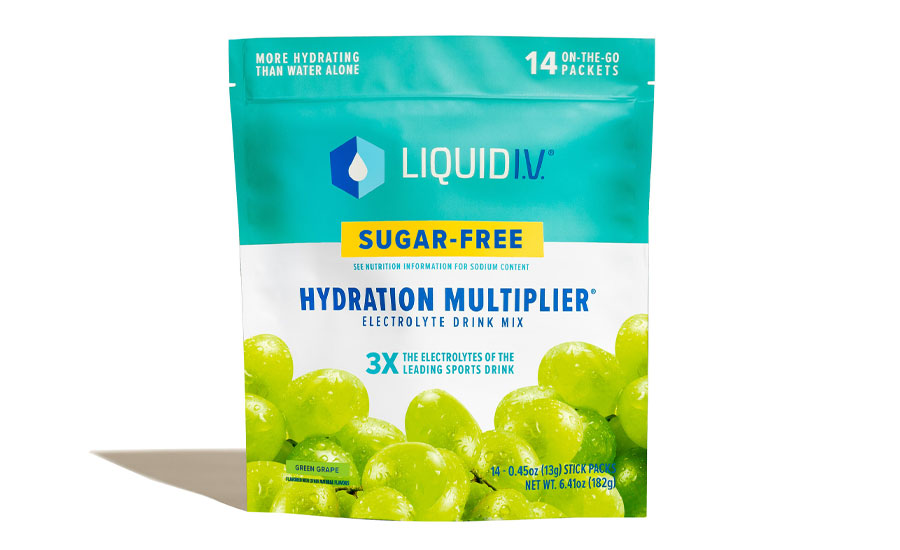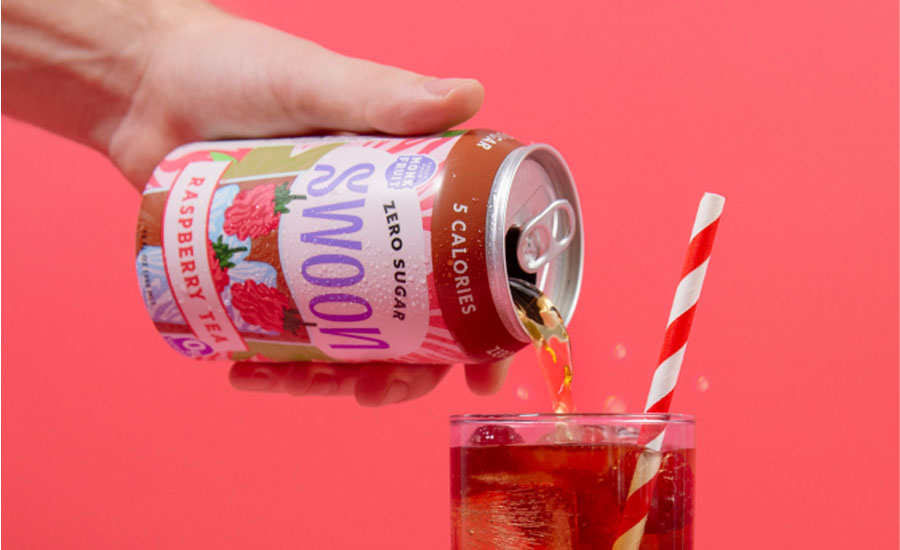R&D Feature
Consumers prefer natural, clean label beverage sweeteners
Producers shifting toward naturalness to meet consumer demands

Image courtesy of Cargill
In her 2022 song “Karma,” pop powerhouse Taylor Swift expresses just how good it feels when someone gets what is coming to them. She compares karma to various things, from the breeze in her hair to a bounty hunter, “Karma’s gonna track you down / Step by step from town to town / Sweet like justice, karma is a queen / karma takes all my friends to the summit,” the now-33-year-old sings.
When it comes to being sweet like karma, consumers are looking for sweeteners that are natural, low in sugar, sustainable and have a high-quality taste.
Those are trends that Papao Saisnith, senior director of global marketing and innovation, sugar and calorie reduction at Tate & Lyle, Hoffman Estates, Ill., points to as influencing the sweetener market.
Sugar reduction has remained top-of-mind for many consumers in the United States, Saisnith notes, especially in their beverages.
“Consumers are paying closer attention to product labeling with calories and total sugars being the first and second attributes looked for on nutrition labels, and often look for food and beverage products with no- or low-sugar added,” she says.
Saisnith explains that consumers tend to gravitate toward products with simple, familiar ingredients, as well as products with short ingredient lists.
“Natural, full-calorie sweeteners like stevia, monk fruit, allulose and erythritol provide non-artificial sweetener claims and clean labeling without all the calories,” she says.
Additionally, many consumers consider sustainability to be an essential component of clean, natural products, Saisnith notes. Sustainability has become “a growing driver of purchase decisions,” because consumers are becoming more aware of the way their food and beverage choices impact the environment, she explains.
Carla Saunders, senior marketing manager for high intensity sweeteners at Cargill, Wayzata, Minn., also points to sugar reduction and naturalness as huge factors influencing the sweeteners market.
“[Consumers] are trying to limit or avoid sugar in their diet, and consider ‘low in sugar’ as one of the top indicators of healthy foods,” Saunders says. “We’re also starting to see consumers’ taste for sweetness adjust, with indications that, in some products, consumers are open to products that are less sweet.”
On the topic of natural ingredients, Saunders says that it is best reflected in claims such as “no artificial sweeteners.”
“Stevia can help brands address both these trends, enabling sugar reduction without artificial sweeteners,” she adds. “It’s also perceived positively by consumers, another reason why we continue to see high demand for this sweetener. Erythritol is another key ingredient in many reduced-sugar beverage formulations. It pairs well with stevia and is used in many high-performing beverages.”
Saunders notes that, while there is still room for indulgence, not every product is a good fit for sugar reduction.
Andrew Martino, category manager of sugar and sweeteners at Cambridge, Mass.-based Global Organics, echoes similar sentiments.
“We have clients that have reduced the amount of sugar in their formulations (without adding other sweeteners) and seen sales go up as a result,” he says. “With so many health concerns or flavor profile issues with non-nutritive sweeteners, just formulating for less sugar is often the cleanest tasting and labeling way to achieve a sugar reduction.”
Martino notes that consumers also are interested in regenerative agriculture as well.
“Organic is inherently regenerative, compared to conventional agriculture,” he explains. “However, for the Native brand sugar we carry, they have taken the extra step of getting Regenerative Organic Certification to show clearly that it meets rigorous third-party standards, and highlight all the sustainability achievements of the farm.”
Thom King, CEO of Portland, Ore.-based Icon Foods, also notes that consumer demand for less sugar and clean label are impacting the market.
“Over the past six months, we have seen press come out about erythritol, then sucralose and now aspartame,” he expresses. “This is driving consumers to allulose, stevia and monk fruit. Thaumatin is still an up-and-comer, but consumer sentiment is positive. The terrain is most definitely shifting in favor of clean label sugar reduction.”

Image courtesy of Liquid I.V.
Shifting to a sweeter perspective
In recent years, consumers’ view of sweeteners has changed. Icon Foods’ King suggests that, over the past five years, sugar “has become public enemy No. 1.”
He says that consumers have become savvier and, therefore, can sniff out any hidden sugars, as well as keep unwanted ingredients on their radars. King expects this shift will be permanent and continue to gain velocity.
King points out that beverage manufacturers have taken a variety of approaches when tackling the challenge of clean label sugar reduction. One method is to reformulate existing products using alternative sweeteners like stevia.
“At Icon Foods, our R&D team works with beverage manufacturers to discover innovative technologies and ingredients that can help reduce sugar content while maintaining taste and texture,” he says. “This includes exploring the use of flavor enhancers, sweetness modulators, fibers, fermentation processes and encapsulation techniques to enhance sweetness perception without relying heavily on nutritive sweeteners.”
Tate & Lyle’s Saisnith echoes similar sentiments, noting that today’s consumers have a greater desire for knowledge, especially when it comes to the sweeteners they’re consuming.
“Consumers are especially tuned into the differences between artificial and non-artificial sweeteners,” she says. “They pay attention to nutrition information and ingredient lists and are recently turning to non-artificial sweeteners like stevia, monk fruit and allulose, because they deliver on health and taste via their clean image.”
Saisnith says that beverage-makers are addressing consumer demands by formulating beverages that are low- to no-calorie “with combinations that address the desire for great taste, improved nutrition and clean labeling.”
Saisnith also notes that younger generations like Gen Z are “eager to explore new flavor combinations,” and that premium and innovative flavors appeal to them. Furthermore, she states that the growing desire for great tasting, healthy beverages is evident in the rising popularity of functional beverages.
“[Functional beverages] typically have low sugar content, few artificial ingredients and are boosted with vitamins, antioxidants, pre and postbiotics, minerals electrolytes and more,” she explains. “Natural, high intensity sweeteners like TASTEVA stevia sweeteners are especially beneficial in functional beverage formulation, as they provide great taste without the sugar or calories.”
Global Organics’ Martino adds that the quantity and quality of the science behind the influence of sugar has caused consumers to take sugar reduction more seriously.
Dylan Bates, business development specialist for new categories at Global Organics, echoes similar sentiments, noting that consumers are becoming much more knowledgeable about the sweeteners used in products.
“In recent years, the typical consumer has become more aware of different sweeteners that may be included in the product that they’re buying, and as a result, there is a far greater diversity when it comes to consumer preferences of what sweeteners they prefer,” he explains.
Cargill’s Saunders cites the company’s proprietary sweetener claim research from 2022 and the proprietary package claim research from this year.
“Americans are more likely to check the amount of sugar versus look for a specific sweetener claim,” she says. “However, sweetener claims can influence purchase. Those that fared best in our survey typically implied ‘natural’ or ‘no artificial sweeteners,’ including ‘naturally sweetened’ or ‘made with a natural sweetener.’”
Saunders notes that sugar content and label-friendly terminology remain important among consumers. Additionally, consumers were open to products with some sugar in the formula, and sustainability is a critical consideration for consumers, she says.
“That’s why we’ve pioneered more sustainable approaches to stevia production,” she states. “Our premier stevia sweetener, EverSweet, gives brands access to the sweetest components of the sweetest components of the stevia leaf — Reb M and Reb D. Because these sweet components comprise less than 1% of the stevia leaf, we use fermentation to produce the sweetener.”
With sugar reduction on the minds of so many consumers, Saunders adds that the shift away from sugar has boosted demand for stevia-based sweeteners.
“Advances in stevia technology are the big reason for this growth, as they make it possible to create great-tasting beverages with less sugar — or even no added sugar,” she notes. “The sweetener also aligns with long-standing, clean-label trends. Our proprietary research finds ‘natural’ claims resonate strongly across all generations, especially Gen Z, where ‘no artificial sweeteners’ claims have the highest impact on purchase.”

Image courtesy of Swoon
Getting a grip on sugars
When it comes to addressing formulation challenges, Tate & Lyle’s Saisnith states that innovation is key.
For solubility solutions, Saisnith points to TASTEVA M and TASTEVA SOL. These sweeteners can be used in combination to “achieve exceptional solubility and sugar-like taste” at high sugar replacement levels, she says.
Additionally, Saisnith points to Tate & Lyle’s DOLICIA PRIMA allulose, which has both the taste and mouthfeel of sucrose, and NATROSE FLAVOR 2.0, which “improves overall flavor quality and reduces bitterness and lingering.”
Cargill’s Saunders notes that stevia “has a strong foothold” in beverages like fruit drinks, value-added waters and sports drinks, but has historically faced issues with flavor, dissolution and solubility. Cargill’s EverSweet stevia sweetener + ClearFlo natural flavor aims to solve those challenges, she says.
“Using EverSweet’s quick sweetness onset and high sweetness potency as a foundation, EverSweet + ClearFlo goes a step further to create an even more sugar-like experience, especially at higher concentrations,” she explains. “The new sweetening system also helps manage off flavors from other ingredients used in formulation, be it earthy notes from proteins, bitterness from caffeine or metallic tastes from potassium chloride.”
Saunders also says that using EverSweet + ClearFlo results in improved dissolution properties, as it dissolves in water at ambient temperatures without the need for heating.
“For beverage processing facilities without heating capabilities, this is a significant advance,” she expresses. “Those same characteristics offer benefits to long-time stevia users, too, as the sweetener system’s near-instantaneous dissolution enables faster manufacturing times.”
Moreover, Cargill’s sweetener system supports simple label declarations, Saunders says. In the U.S., EverSweet can appear on ingredient statements as stevia sweetener, while ClearFlo labels as a natural flavor, she explains.
“EverSweet + ClearFlo represents a tremendous leap forward, offering significant improvements in taste, solubility, dissolution and stability,” Saunders says. “It will enable formulators to use stevia in categories that previously weren’t able to access its sugar-reduction power.”
Leaning in to beverage blending
Icon Foods’ King compares the beverage tasting experience to that of a symphony — it is multi-layered and much more complex than a single cello. While the cello is great, he says the symphony is “a full sensorial experience.” The same goes for the sweetening system or blend, he says.
“When it comes to beverage formulation, finding the right balance between sweetness and health-consciousness and mouthfeel all working in concert, is a constant challenge for manufacturers,” King says. “At Icon Foods, we specialize in the blending of natural sweeteners, modulators and fibers in beverage formulation for our customers. As the demand for healthier options arises, incorporating a blend of natural sweeteners has emerged as a preferred approach with numerous benefits, including improved taste and texture.”
King explains that using a variety of natural sweeteners can create a more complex and well-rounded flavor profile, as each sweetener brings its unique taste characteristics. Blending the sweeteners together can “provide a harmonious balance of sweetness that extends across the entire pallet, front to back.”
He suggests that, by using sweeteners that complement each other, the formulation process can be more efficient and cost-effective.
Smaro Kokkinidou, Cargill’s principal food scientist, simply says that sugar reduction can be a complicated process.
For higher levels of sugar reduction, she notes that it’s often necessary to use sweetener blends, pairing high intensity options with other complementary sweeteners.
“Erythritol is a common partner, as it does a nice job of boosting stevia’s up-front sweetness and rounding out its sweetness profile without adding to the calorie load,” Kokkinidou explains. “Further, with limited sugar in the formulation, reduced- and no-sugar-added beverages often have a thin, watery mouthfeel. Including a bit of erythritol helps build body into the beverage.”
In the United States, erythritol might appear on ingredient statements as “natural flavor” when it’s used at an inclusion level of 1.25% or lower, Kokkinidou notes.
Global Organics’ Bates also notes the benefits when blending sweeteners.
“Sweeteners are typically blended in order to achieve better taste or texture than a single sweetener can provide,” he says. “For example, stevia is a calorie-free sweetener, but has bitter notes. It may be combined with sugar or another sweetener to help mask those bitter notes while keeping calorie counts low.”
Tate & Lyle’s Saisnith states that successful sweetening solutions are built from a combination of ingredients.
“Combinations allow beverage formulators to create low/no calorie beverages with great consumer accepted taste experiences,” she says. “Combinations of sweeteners can optimize the sweetening system and provide sweet taste, balance flavors and minimize bitterness or off notes while maintaining caloric and cost targets.”
Looking for a reprint of this article?
From high-res PDFs to custom plaques, order your copy today!








